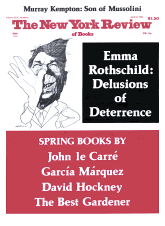In response to:
Founding Uncle from the January 20, 1983 issue
To the Editors:
In Robert O. Paxton’s review of Léon Blum [NYR, January 20], there are a couple of interconnected points which could use clarification. Paxton says that “economic planning was a vogue of the right in the 1930s,” and that socialist “planistes” followed Marcel Déat in his authoritarian socialism. In general, French Rightists of the 1930s were not “planistes,” but corporatists, fearful of a strong directive state. Planning was “in vogue” among certain business, labor and intellectual groups, but few of them were of the Right. Key individuals and allies of the Socialists were “planistes,” including the leadership of the largest union, the CGT. Although influenced by Henri de Man, they had no ties to Marcel Déat. And Paxton fails to mention Blum’s second, short-lived Popular Front Cabinet of March 1938, which had a decidedly interventionist and “planiste” bent, and included the technocrat Pierre Mendès-France.
Second, Paxton accuses Lacouture of imposing an anachronistic view of America on the thirties, and writes that “the America of Blum’s affection, so far from having become the Gaullian monster of today, was still the reassuringly distant ally.” America was not an ally of France in 1936, and for many Frenchmen, it was neither reassuring nor distant enough. In fact, the French love-hate relationship with America began in the interwar period, when the French felt increasingly threatened by America’s financial and economic might and its encroaching cultural imperialism. For the Right, America represented both decadence and barbarous mediocrity. For many on the Left, America was the bastion of rampant capitalism, constantly in search of more exploitative and alienating means of production. French literature of the thirties is filled with a combined awe and disdain for the Yankee behemoth, “the American cancer.” For most Frenchmen, Chaplin’s Modern Times was America. Ironically, Blum respected Roosevelt for the “planiste” elements of the New Deal, for the muscular liberalism which seemed so vibrant and humane compared to the impotent liberalism of the Third Republic.
David M. Ennis
Boston College
Chestnut Hill, Massachusetts
Robert O Paxton replies:
David Ennis adds useful nuance to my rather schematic comparison. I stick to my main point, however: with respect to both the acceptability of economic planning and the strong presence of the United States, and in other respects as well, the Mitterrand government belongs to a world profoundly different from that of the Popular Front.
A brief enthusiasm for “the plan” was very widespread in France in 1934-1935, as Mr. Ennis indicates. Its adepts on the left were young syndicalists, technocrats and anticommunists, mostly attached to trade unions rather than to any party, some of whom wound up in the Resistance (Robert Lacoste) and many of whom wound up at Vichy (René Belin, Charles Spinasse, Georges Lefranc). In any event, Blum and the SFIO majority decisively rejected planning before 1936 because it meant consolidating capitalism by “accepting the intermediate stage of a mixed economy,” as Richard F. Kuisel puts it.
As for America, a cultural distaste can be traced back in France even further than the “America the Menace” literature of Georges Duhamel and Robert Aron in the 1930s. But the real power relationship facing Blum bore little resemblance to that confronting all French leaders since about 1942. American banks and films may have affected France profoundly, but the American army in 1936 was smaller than the Belgian army.
This Issue
April 14, 1983



